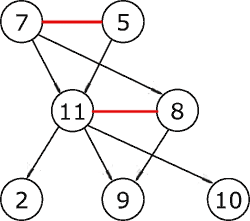Moral graph
A moral graph is a concept in graph theory, used to find the equivalent undirected form of a directed acyclic graph. It is a key step of the junction tree algorithm, used in belief propagation on graphical models.
The moralized counterpart of a directed acyclic graph is formed by connecting nodes that have a common child, and then making all edges in the graph undirected. Equivalently, a moral graph of a directed acyclic graph G is an undirected graph in which each node of the original G is now connected to its Markov blanket. The name stems from the fact that, in a moral graph, two nodes that have a common child are required to be married by sharing an edge.


See also
- D-separation
- Tree decomposition
References
- Cowell, Robert G.; Dawid, A. Philip; Lauritzen, Steffen L., Spiegelhalter, David J. (1999). "3.2.1 Moralization". Probabilistic Networks and Expert Systems. Springer-Verlag New York. pp. 31–33. ISBN 0-387-98767-3.
- M. Studeny: On mathematical description of probabilistic conditional independence structures